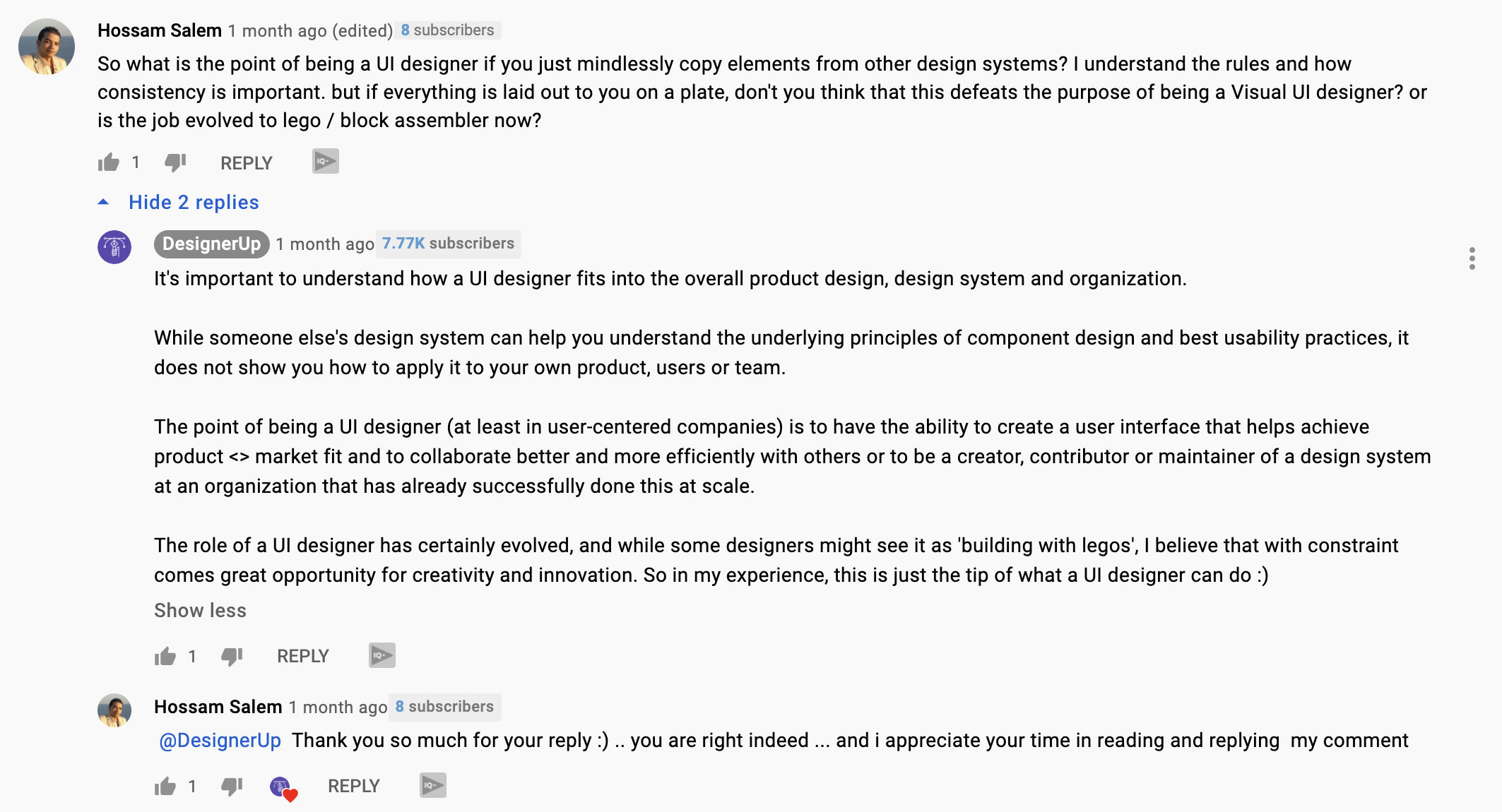Whenever we interact with others, in our life, in our job or on the internet, sometimes we get love, appreciation and acknowledgment for our efforts and other times we get push-back, criticism or disregard.
I’ve learned that how you think about the reactions of others and how you respond to them can make a world of difference for the outcome of the conversation, your own sanity and can even help someone else along the way.
When you’ve worked in tech, especially as a woman of color for as long as I have and when you make content online sometimes you get comments like this.

If you’re wondering, this was in response to this video about learning and stealing from Design Systems.
Even though this may seem kind of jarring and rude at first, it’s been my experience that many comments and conversations like these present an opportunity to understand and connect more deeply with people, if you know how to look and how to respond.
It’s easy to make the assumption that people on the internet are mean, or stupid or pass judgment against them (and sometimes there are people that intentionally or unintentionally express themselves in unhealthy ways), but I prefer to see them as a gift and a chance to practice my empathy as a designer, my communication skills and my personal values of mindfulness and compassion.
As psychologist, Adam Grant puts it “There is a difference between being open-minded and being ‘actively’ open-minded.”
To be actively open-minded and empathetic means we don’t shy away from difficult conversations and we seek out opposing points of view. But we need the be equipped with the right intention, inner-space and response techniques first. Which as UX designers and product designers start with empathy and can be cultivated through mindfulness.
Inspired by the self-compassion exercises of the great Tara Brach’s RAIN and the non-violent communication technique of Dr. Marshal Rosenberg. I’ve outlined a simple technique into an easy-to-remember acronym that any designer can use when they find themselves having to respond to or deal with difficult people.
I call it NAEBR.
NAEBR pronounced Neighbor is a way for us to look at the offender not as the other but as more of an acquaintance that’s having a rough day.Here’s how NAEBER works.
- Notice — notice and recognize what’s going on — Look at what’s being said or written without judging it.
- Acknowledge — recognize the experience that you’re having and any feelings and emotions that come up surrounding it.
- Empathize — Imagine what it’s like to be in their shoes and what might have made them respond the way they did.
- Break- Take a moment and breath and give the situation time to settle (take all the time you need!)
- Respond — This is where you have the choice to forgive and let it go, politely decline, or simply and matter of factly craft a response that is not biased by your own perceptions or emotions.
Just like the person that lives next door to you, you may not know them very well or know what they are going through, but you are in each other’s space and want things be as harmonious and pleasant as possible while maintaining your privacy, boundaries and expressing your needs clearly.
So let’s see how this might work with a supervisor or colleague.
Your boss or supervisor says: “I don’t think that’s the direction we want to go in with these designs.”
Your first thought and reaction might be:
“My boss is a jerk, she never takes my suggestions seriously, I’m probably terrible at my job, I don’t know why they can’t see how important this is I worked really hard on it, I’m gonna get fired.”
and any mix of blame, anger, judgment and giving up.
This leads us down all sorts of paths of less than useful thoughts, actions, beliefs and narrative creation. We might end up disqualifying ourselves or getting so nervous that we mess up or come across as not confident, we might get upset and say something we don’t mean or not say or do anything at all further reinforcing our story.
But if we take a minute to think about them as our NAEBR it might play out like this:
Your boss or supervisor says: “I don’t think that’s the direction we want to go in with these designs.”
Now we can apply the NAEBR method:
Notice: “This person is my superior and they are saying words.”
Acknowledge: “I feel hurt by these words and it makes me feel like an imposter and fearful about my job security.”
Empathize: “They must be under a lot of pressure themselves and have a lot of other factors that are driving their decisions — it’s not entirely about me, as a matter of fact, I’m mostly good at what I do and I like my position here or maybe I don’t like my position here.”
Break: “Take a deep breath and give yourself space to think and to process.” (Maybe step out of the room, go for a walk, or revisit it the next day or week).
Respond: Now you can decide what would be most helpful for you. You could write an email saying. “I want to know how I could be a more valuable player, focus on the right things and contribute in a more effective way. Would you have 5 minutes to spare to help me grow today?”
Mindfulness and empathy (towards others and ourselves) help us get out of a defensive or fearful stance by putting ourselves in a curious and observational mindset, it also allows us to see opportunities that are hard for us to see when we are in that fight or flight state of mind.
👀 If you're wondering how I responded you can view the comment here.

Although we can’t control how people will respond or guarantee a favorable outcome, what we can control is how we respond and how we let the conversation affect us. It’s not always easy or comfortable and it takes practice, but as designers, we know the importance of practicing our craft, and empathy and good communication are central to that. So the next time someone rubs you the wrong way think of them as your NAEBR. You might be surprised at what unfolds.
